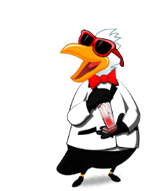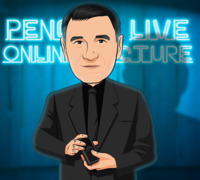
 Solid lecture with effects you will use
Report this review
Solid lecture with effects you will use
Report this review
Verified buyer
Pro Privacy ON
(login to see reviewer names)
on April 14th, 2014
I have been intrigued by the work Christopher Taylor has been doing with his Taylor Imagineering. As
one who shies away from electronics in performing (in terms of method), I have not been willing to
invest in his creations, no matter how wonderful.
But, I was really interested in this lecture. I wanted to get a chance to see how his mind ticks. I am so glad I did.
Ken de Courcy published an effect in his Coffee Break Chronicles called "Last Two Cards Match." (I guess Larry Becker did something along this plot line, too, "Will The Cards Match.") Christopher layers an incredible, eerie story line about women who were murdered and the men who murdered them. It takes the effect to a whole new place, and it is nice. (This one is called "Overkill." Included at no extra charge with the lecture are the pictures you can print out on photograph paper or card stock to perform this.)
He also demonstrated a key-bending routine. I have moved away from bending, but I like how brings his own keys and allows the spectator to choose which one will be used. He shows how he does an elecontrically enhanced version, which I liked better than the other version. However, if you have the slightest bit of experience with equivoke, then you will be able to perform the electronically enhanced version without any electronics.
"Half-Track" is an interesting Think-of-a-Card effect. As he was performing it, I thought of two different ways to execute it before he explained it, both were different (though one only slightly) from how he performs it. Two spectators are each given about half of the deck. They go through their cards and select 10. From the 10, they select one and put in the other's packet, so each are still holding 10 cards. Each packet is shuffled. The two are placed together, and without looking at the faces of the cards, Christopher was able to determine who picked what. This is simple and very effective. Because the deck is a regular deck and because they are not stacked, you can go into any other card effect you want.
I don't do PK Touches, but Christopher has an intriguing version that I want to try. To me, it is a very bold method, and I would love to hear from someone who has performed it. It is wild. If this is your kind of thing, then you should try it out.
I do not use impression devices, but I am obscessed by them. I have purchased so many different books/ebooks on how to construct them, but I never use them in performance. Christopher shows how to make an impression device using a card box. In the way he demonstrated it, the impression seems more readable than most I have worked with.
For those of you who like Charles Gaucci's "Eye to Eye" but are reluctant to perform it because of what the method involves, check out Christopher's "Which Hand?" effect, "Enso." It involves the Out to Lunch principle, which I have never been a fan of, but, check out the method. It might give you additional ideas on how to use the Gaucci gimmick if you own it. Christopher explains how to construct a block of business cards used in this effect during the lecture, but he and Penguin Magic also include a separate video, free with lecture purchase, on the nuts and bolts of constructing it.
During his interview with host Dan Harlan, you get to see what a wonderful man Christopher is.
But, I was really interested in this lecture. I wanted to get a chance to see how his mind ticks. I am so glad I did.
Ken de Courcy published an effect in his Coffee Break Chronicles called "Last Two Cards Match." (I guess Larry Becker did something along this plot line, too, "Will The Cards Match.") Christopher layers an incredible, eerie story line about women who were murdered and the men who murdered them. It takes the effect to a whole new place, and it is nice. (This one is called "Overkill." Included at no extra charge with the lecture are the pictures you can print out on photograph paper or card stock to perform this.)
He also demonstrated a key-bending routine. I have moved away from bending, but I like how brings his own keys and allows the spectator to choose which one will be used. He shows how he does an elecontrically enhanced version, which I liked better than the other version. However, if you have the slightest bit of experience with equivoke, then you will be able to perform the electronically enhanced version without any electronics.
"Half-Track" is an interesting Think-of-a-Card effect. As he was performing it, I thought of two different ways to execute it before he explained it, both were different (though one only slightly) from how he performs it. Two spectators are each given about half of the deck. They go through their cards and select 10. From the 10, they select one and put in the other's packet, so each are still holding 10 cards. Each packet is shuffled. The two are placed together, and without looking at the faces of the cards, Christopher was able to determine who picked what. This is simple and very effective. Because the deck is a regular deck and because they are not stacked, you can go into any other card effect you want.
I don't do PK Touches, but Christopher has an intriguing version that I want to try. To me, it is a very bold method, and I would love to hear from someone who has performed it. It is wild. If this is your kind of thing, then you should try it out.
I do not use impression devices, but I am obscessed by them. I have purchased so many different books/ebooks on how to construct them, but I never use them in performance. Christopher shows how to make an impression device using a card box. In the way he demonstrated it, the impression seems more readable than most I have worked with.
For those of you who like Charles Gaucci's "Eye to Eye" but are reluctant to perform it because of what the method involves, check out Christopher's "Which Hand?" effect, "Enso." It involves the Out to Lunch principle, which I have never been a fan of, but, check out the method. It might give you additional ideas on how to use the Gaucci gimmick if you own it. Christopher explains how to construct a block of business cards used in this effect during the lecture, but he and Penguin Magic also include a separate video, free with lecture purchase, on the nuts and bolts of constructing it.
During his interview with host Dan Harlan, you get to see what a wonderful man Christopher is.
Add a comment
OPEN BOX
$22.79 (42% OFF)
57
Bestsellers
See all bestsellers
COOL BOX
24% now claimed
0
9
:
3
9
:
4
3
remaining

Act Builder beta



























